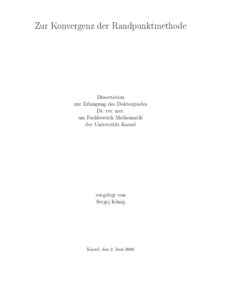Datum
2008-09-24Autor
König, SergejSchlagwort
500 Naturwissenschaften 510 Mathematik ApproximationstheorieRandwertproblemStokes-GleichungPartielle DifferentialgleichungInterpolationMetadata
Zur Langanzeige
Dissertation

Zur Konvergenz der Randpunktmethode
Zusammenfassung
Das von Maz'ya eingeführte Approximationsverfahren, die Methode der näherungsweisen Näherungen (Approximate Approximations), kann auch zur numerischen Lösung von Randintegralgleichungen verwendet
werden (Randpunktmethode). In diesem Fall hängen die Komponenten der Matrix des resultierenden Gleichungssystems zur Berechnung der Näherung für die Dichte nur von der Position der Randpunkte und der Richtung der äußeren Einheitsnormalen in diesen Punkten ab. Dieses numerisches Verfahren wird am Beispiel des Dirichlet Problems für die Laplace Gleichung und die Stokes Gleichungen in einem beschränkten zweidimensionalem Gebiet untersucht. Die Randpunktmethode umfasst drei Schritte: Im ersten Schritt wird die unbekannte Dichte durch eine Linearkombination von radialen, exponentiell abklingenden Basisfunktionen approximiert. Im zweiten Schritt wird die Integration über den Rand durch die Integration über die Tangenten in Randpunkten ersetzt. Für die auftretende Näherungspotentiale können sogar analytische Ausdrücke gewonnen werden. Im dritten Schritt wird das lineare Gleichungssystem gelöst, und eine Näherung für die unbekannte Dichte und damit auch für die Lösung der Randwertaufgabe konstruiert. Die Konvergenz dieses Verfahrens wird für glatte konvexe Gebiete nachgewiesen.
werden (Randpunktmethode). In diesem Fall hängen die Komponenten der Matrix des resultierenden Gleichungssystems zur Berechnung der Näherung für die Dichte nur von der Position der Randpunkte und der Richtung der äußeren Einheitsnormalen in diesen Punkten ab. Dieses numerisches Verfahren wird am Beispiel des Dirichlet Problems für die Laplace Gleichung und die Stokes Gleichungen in einem beschränkten zweidimensionalem Gebiet untersucht. Die Randpunktmethode umfasst drei Schritte: Im ersten Schritt wird die unbekannte Dichte durch eine Linearkombination von radialen, exponentiell abklingenden Basisfunktionen approximiert. Im zweiten Schritt wird die Integration über den Rand durch die Integration über die Tangenten in Randpunkten ersetzt. Für die auftretende Näherungspotentiale können sogar analytische Ausdrücke gewonnen werden. Im dritten Schritt wird das lineare Gleichungssystem gelöst, und eine Näherung für die unbekannte Dichte und damit auch für die Lösung der Randwertaufgabe konstruiert. Die Konvergenz dieses Verfahrens wird für glatte konvexe Gebiete nachgewiesen.
The method of approximate approximations, introduced by Maz'ya, can also be used for the numerical solution of boundary integral equations. In this case, the matrix of the resulting algebraic system to compute an approximate source density depends only on the position of a finite number of boundary points and on the direction of the normal vector in these points (Boundary Point Method). This approach is investigated for the Dirichlet problem for the Laplace equation and the Stokes equations in a bounded 2-dimensional domain. The numerical approach covers three steps: In a first step the unknown potential density is replaced by a linear combination of exponentially decreasing basis functions concentrated near the boundary points. In a second step, integration over the boundary is replaced by integration over the tangent vectors at the boundary points such that even analytical expressions for the potential approximations can be obtained. In a third step, finally, the linear algebraic system is solved to determine an approximate density function and the resulting solution of the Dirichlet problem. The convergence of this method is shown for smooth convex domains.
Zitieren
@phdthesis{urn:nbn:de:hebis:34-2008092424061,
author={König, Sergej},
title={Zur Konvergenz der Randpunktmethode},
school={Kassel, Universität, FB 17, Mathematik},
month={09},
year={2008}
}
0500 Oax
0501 Text $btxt$2rdacontent
0502 Computermedien $bc$2rdacarrier
1100 2008$n2008
1500 1/ger
2050 ##0##urn:nbn:de:hebis:34-2008092424061
3000 König, Sergej
4000 Zur Konvergenz der Randpunktmethode / König, Sergej
4030
4060 Online-Ressource
4085 ##0##=u http://nbn-resolving.de/urn:nbn:de:hebis:34-2008092424061=x R
4204 \$dDissertation
4170
5550 {{Approximationstheorie}}
5550 {{Randwertproblem}}
5550 {{Stokes-Gleichung}}
5550 {{Partielle Differentialgleichung}}
5550 {{Interpolation}}
7136 ##0##urn:nbn:de:hebis:34-2008092424061
<resource xsi:schemaLocation="http://datacite.org/schema/kernel-2.2 http://schema.datacite.org/meta/kernel-2.2/metadata.xsd"> 2008-09-24T12:03:30Z 2008-09-24T12:03:30Z 2008-09-24T12:03:30Z urn:nbn:de:hebis:34-2008092424061 http://hdl.handle.net/123456789/2008092424061 4936079 bytes application/pdf ger Urheberrechtlich geschützt https://rightsstatements.org/page/InC/1.0/ approximate approximations boundary point method Stokes potentials partial differential equations quasi interpolation 500 510 Zur Konvergenz der Randpunktmethode Dissertation Das von Maz'ya eingeführte Approximationsverfahren, die Methode der näherungsweisen Näherungen (Approximate Approximations), kann auch zur numerischen Lösung von Randintegralgleichungen verwendet werden (Randpunktmethode). In diesem Fall hängen die Komponenten der Matrix des resultierenden Gleichungssystems zur Berechnung der Näherung für die Dichte nur von der Position der Randpunkte und der Richtung der äußeren Einheitsnormalen in diesen Punkten ab. Dieses numerisches Verfahren wird am Beispiel des Dirichlet Problems für die Laplace Gleichung und die Stokes Gleichungen in einem beschränkten zweidimensionalem Gebiet untersucht. Die Randpunktmethode umfasst drei Schritte: Im ersten Schritt wird die unbekannte Dichte durch eine Linearkombination von radialen, exponentiell abklingenden Basisfunktionen approximiert. Im zweiten Schritt wird die Integration über den Rand durch die Integration über die Tangenten in Randpunkten ersetzt. Für die auftretende Näherungspotentiale können sogar analytische Ausdrücke gewonnen werden. Im dritten Schritt wird das lineare Gleichungssystem gelöst, und eine Näherung für die unbekannte Dichte und damit auch für die Lösung der Randwertaufgabe konstruiert. Die Konvergenz dieses Verfahrens wird für glatte konvexe Gebiete nachgewiesen. The method of approximate approximations, introduced by Maz'ya, can also be used for the numerical solution of boundary integral equations. In this case, the matrix of the resulting algebraic system to compute an approximate source density depends only on the position of a finite number of boundary points and on the direction of the normal vector in these points (Boundary Point Method). This approach is investigated for the Dirichlet problem for the Laplace equation and the Stokes equations in a bounded 2-dimensional domain. The numerical approach covers three steps: In a first step the unknown potential density is replaced by a linear combination of exponentially decreasing basis functions concentrated near the boundary points. In a second step, integration over the boundary is replaced by integration over the tangent vectors at the boundary points such that even analytical expressions for the potential approximations can be obtained. In a third step, finally, the linear algebraic system is solved to determine an approximate density function and the resulting solution of the Dirichlet problem. The convergence of this method is shown for smooth convex domains. open access König, Sergej Kassel, Universität, FB 17, Mathematik Varnhorn, Werner (Prof. Dr.) Specovius-Neugebauer, Maria (Prof. Dr.) Borchers, Wolfgang (Prof. Dr.) 31A10 31A25 31A35 31C20 35J25 35J05 Approximationstheorie Randwertproblem Stokes-Gleichung Partielle Differentialgleichung Interpolation 2008-08-26 </resource>
Die folgenden Lizenzbestimmungen sind mit dieser Ressource verbunden:
Urheberrechtlich geschützt

